 |
Crawford County, Kansas |
 |
| |
Legend
has it that Dr. C. H. Strong went on a hunting trip on
February 22, 1868 for deer and a location for a county
seat. He shot the deer and where it fell is now the lawn
of the courthouse in Girard. He named the new county
seat Girard, after his home town of Girard, Pennsylvania.
On June 1, 1868, Strong organized the Girard Town Company
and began laying out the new town. The
first passenger train arrived in Girard on March 3, 1870.
Girard became a city of the third class by 1871 and the
first city council met in April of that year. Girard
became a first class city at the turn of the century.
(see Crawfordsville history
for the county seat battle) |
| |
|
 |
Central School - Girard
- postmarked 1908 |
High School - Girard
- no postmark (1907 - 1914) |
| |
 |
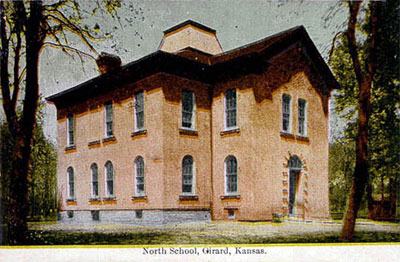 |
High School - Girard
- photo 1953 |
North School - Girard
- postmarked 1909 |
| |
|
 |
 |
South School - Girard
- postmarked 1910 |
A.T. & Sante Fe Station
- Girard
- postmarked 1912 |
| |
|
 |
 |
West Side of Square - Girard
- photo early 1900's (courtesy - late
Gene DeGrusen, PSU Axe Library) |
South Side of Square - Girard
- photo early 1900's (courtesy - late
Gene DeGrusen, PSU Axe Library) |
| |
|
 |
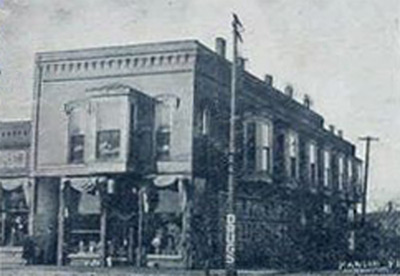 |
North Side of Square - Girard
- postmarked 1910 |
Phil's Drug Store- Girard
- photo early 1900's (courtesy Dorothy
Benskin,Crawford County Genealogical Society) |
| |
|
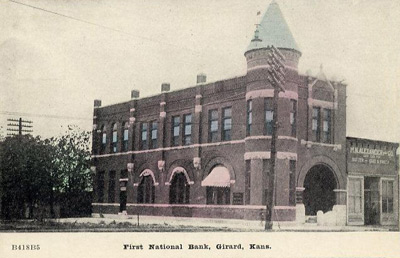 |
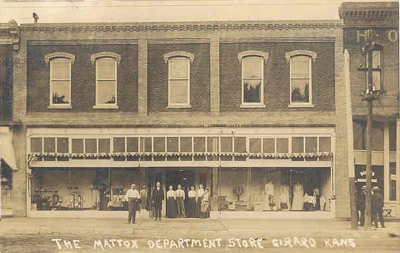 |
First National Bank - Girard
- no postmark (1907 - 1914) |
Mattox Department Store -
Girard
- photo early 1900's (courtesy Dorothy
Benskin,Crawford County Genealogical Society) |
| |
|
 |
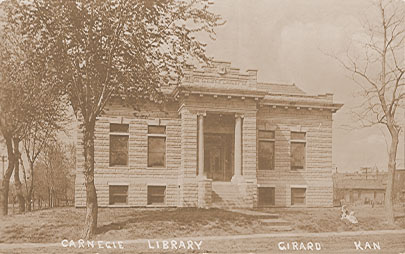 |
Raymond Park Bridge - Girard
- photo early 1900's |
Carnegie Library - Girard
- photo 1909 |
| |
|
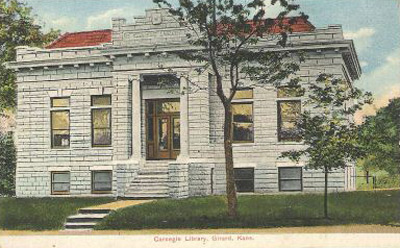 |
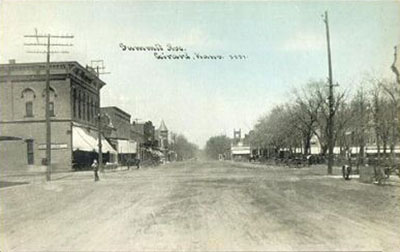 |
Carnegie Library - Girard
- no postmark (1907 - 1914) |
Summit Avenue - Girard
- no postmark (1907 - 1914) |
| |
|
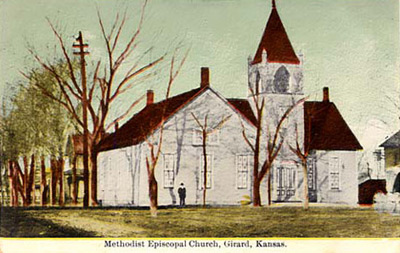 |
 |
Methodist Episcopal Church
- Girard
- no postmark (1907 - 1914) |
Methodist Church - Girard
- photo 1961 |
| |
|
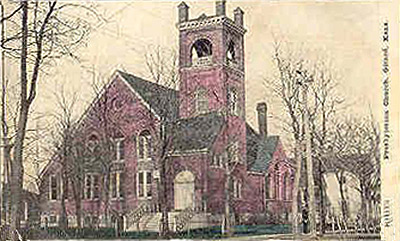 |
Presbyterian Church - Girard
- postmarked 1908 |
| |
 |
| |
More About Girard
|
"This city, the county seat
of Crawford County, is located on a gently undulating prairie
at the center of the county. It is regularly laid out, has
a public square in the center, surrounded by numerous fine
business buildings, many of them of brick, and has a large
proportion of neat frame residences, surrounded by incipient
shade trees. Its elevation is 988 feet above the sea. The
town was started in the spring of 1868, in opposition to
Crawfordville. The Girard Town Company was first composed
of the following gentlemen: A. Danford, President; C. H.
Strong, Secretary; Dr. Couch, Dr. B. F. Hepler, E. J. Boering,
Levi Hatch, John Lash, D. S. McIntosh and Col. J. Alexander.
This company was formed upon the survey of the railroad through
this portion of the county and the town located upon the
line. it was named by C. H. Strong, after the town Girard,
in Pennsylvania, which had previously been his home.
The first buildings erected in Girard were by the following parties, in the order
given: Col. J. Alexander, a general store; C. H. Strong, a dwelling house; Chauncey
Doyle, a saloon; N. Sinnet, a general store. Some time during this year (1868)
the first blacksmith shop was opened in the town; the first frame house was built
by A. A. Fletcher, and the first hotel was opened early in the year. In December,
James Hull erected the first part of a building which was used temporarily as
a court house. The first birth in Girard was that of Mary Fletcher, daughter
of Mr. and Mrs. A. A. Fletcher; the first marriage, that of A. J. Vickers to
Miss Margaret McIntosh, and the first death that of Mrs. Dr. L. F. Crawford in
the spring of 1869. Immediately after the death of this lady, Judge McIntosh
located the cemetery southwest of the town. The first celebration in Girard occurred
on July 4, 1868. It was a Sunday school celebration and a celebration of the
nation's natal day, both in one. The Hon. A. Danford and Dr. Couch were the orators
of the day. When these festivities took place the town had made considerable
progress.
There were three stores, a saloon and about six dwelling houses within its limits.
Still its growth, until the fall of 1869, was much slower than would have been
the case had it not been for the difficulties over the building of the railroad.
When these were settled, when it became known that the railroad would come despite
all opposition, opposition in a measure ceased, and the development of the county
and its towns made more rapid strides. In February, 1870, Girard had five hotels,
eight saloons, six grocery stores, five dry goods stores, two hardware stores,
two furniture stores, one drug store, one newspaper and job; printing office,
other businesses in proportion, and seventy-two dwelling houses, a total of 140
buildings. On the 10th of this month the location of the depot of the M. R.,
F. S. & G. R. R. was determined upon, in the north part of the town, by Mr.
Chanute, and, on the 12th, a meeting was held to prepare to appropriately celebrate
the advent of the iron horse whenever that advent should take place. it was universally
realized by the citizens that that event, which no one could prevent, as had
been proved, was one of great significance, and the preparations made were commensurate
with its importance. The celebration came off on the 3d of March, the day on
which the first passenger train reached the town. This train brought down 200
of the leading citizens and dignitaries of Fort Scott, who united with the citizens
of Girard in a jollification, the equal of which, in heartiness and enthusiasm,
is seldom witnessed, for the former were as much interested as the latter in
the success of the enterprise of building the railroad through the neutral lands.
The telegraph wire was put up to Girard on the 232d of March. During this spring
a schoolhouse was built by Frank Playter, Trustee, and W. H. Warner, Secretary
of the School Board, and several church organizations were effected. The town
had been incorporated and a Board of Trustees appointed by the Probate Judge
on the 10th of the preceding November; but so long as Girard remained the terminus
of the railroad the disorderly classes were numerous and large, and all the influences
that could be brought to bear by the civil authorities, by the churches and by
the moral elements of society, were much more than counterbalanced by the seventeen
saloons that for some time were in full and constant blast.
The necessity for some special effort in the direction of temperance was clearly
perceptible, and in the winter of 1871-72, a lodge of the I. O. G. T. was organized,
which did what could be done to prevent the granting of licenses. but the first
Board of Trustees, having been appointed by the Probate Judge, did not feel that
their authority was derived from the people, neither did they feel sure that
the people would sustain them in vigorous measures to suppress salooning, and,
as a consequence, matters were permitted to take their own course until the railroad
had been built south and until a Board of Trustees had been elected by the people.
Then an impression began gradually to be made. But it was not until after the
Murphy movement commenced, in 1878, that satisfactory results were achieved.
In that year a blue ribbon lodge was organized, of which C. Dana Sayrs was President,
E. W. Majors, Secretary, and Miss Jennetta McMurray Treasurer. This organization
vigorously prosecuted the temperance work until the prohibition amendment to
the constitution was adopted by the people, since which time there has been no
open saloon in Girard, and peace and prosperity have prevailed. In Girard Precinct
the majority for the amendment was 248, while in the county it was only 186.
The first Board of Trustees, appointed November 10, 1869, was as follows: L.
F. Crawford, N. Sinnet, D. W. Burnet, W. E. Blandon and James Hull. On the 10th
of April, 1870, an election was held for a new board, resulting in the selection
of the following gentlemen: A. J. Vickers, George Eyestone, Harvey Brown, William
Reynolds and A. B. Turner.
Under a law passed in March, 1871, Girard became a city of the third class, and
in the early part of April elected her first city officers. The last meeting
of the trustees was held April 5, and the first meeting of the new Council was
held on the 7th. The result of the election was that George Ryan had been chosen
Mayor, and A. J. Vickers, J. E. Raymond, E. Fanger, H. P. Grund and F. B. Andrus,
Councilmen. At the first meeting of the Council, A. M. Cook was elected Clerk.
Since that time the following gentlemen have been elected Mayor of Girard: George
Ryan, 1872; J. E. Raymond, 1873; Thomas Ping, 1874; James McMurray, 1875; J.
Riffer, 1876 and 1877; M. Robinson, 1878; J. D. Barker, 1879 and 1880; Joseph
Ennis, 1881; John Tontz, 1882. The post office was established in Girard early
in 1868, C. H. Strong being appointed first Postmaster. He was succeeded by N.
Sinnet, who, on account of his opinions on the neutral land controversy, was
opposed by the "settlers," and was removed and succeeded by F. Danford,
in 1870. George Ryan was appointed in September, 1870, H. E. Perkins in July,
1873, C. G. Hawley in 1875, and Eli Wasser was appointed in 1883. The first meeting
of the School Board of the Girard, District No. 37, was held August 7, 1869.
d. S. McIntosh was Director; F. Playter, Clerk; and L. F. Crawford, Treasurer.
In response to a petition of the citizens, an election was appointed for November
26, 1869, for the purpose of voting on the issuance of $1,000 in bonds for the
building of a schoolhouse. The vote was unanimous in their favor, and the contract
for building the schoolhouse was let to Gardner
& Bowman for $640. Miss Maggie T. Hill taught the first
school in the new building in the summer of 1870, for
$40 per month. In the spring of 1872, at an election held
for that purpose, &15,000 in bonds were voted for
the building of a new schoolhouse. This building was commenced
in the fall of 1872, and completed in the spring of 1873.
The main part of it is 58x44 feet in dimensions, and three
stories high, including the basement, which is of stone
- the two upper stories being of brick. The total cost
of the building was $13,300. The Principals of the school
have been Prof. A. F. Allen, commencing April, 1873; Prof.
H. Quick, 1877, and the present Principal, John Randolph
commencing in July, 1881. A high school was established
in the fall of 1882.
CHURCHES AND SOCIETIES.
The Methodist Church was organized in 1869, Rev. Robert Stalker preaching the
first sermon, in that year, in the upper story of a house owned by A. A. Fletcher
on the north side of the public square. This was probably the first sermon preached
in Girard. Rev. Thomas B. Palmer preached in the schoolhouse April 16, 1870.
The following have been the pastors of the church: Rev. J. A. Kershner, 1871;
J. E. H. Day, 1872; Thomas Moffett, a short time; W. McWhirt, 1873; H. A. Tucker,
1879; C. C. Boaz, 1880, and C. C. Durborow, 1881, 1882 and 1883. During Mr. Durborow's
ministry Girard became a station. Up to 1873 the society occupied the Presbyterian
Church, but in that year Rev. Mr. McWhirt bought the schoolhouse which was built
by the Girard district in 1870, becoming himself individually responsible for
the purchase in order to be no longer without a church. The society purchased,
in 1877, two lots at the corner of Summit avenue and Buffalo street, paying therefor
$450. In the same year they commenced the erection of a church building, a frame
structure 40x60 feet, and costing $2,900. A neat parsonage has also been provided,
and the value of the church property - two lots, church building and parsonage
- is $4,000. The membership is at present 140. There is also an excellent Sunday
school connected with the church, having an enrollment of 160 scholars. S. R.
Tuttle is Superintendent.
The Presbyterian Church was organized in 1869. At a meeting of the trustees held
December 18, a building committee was appointed. A festival was given January
27, 1870, in aid of the building fund, at which $218.30 was realized. February
12, a meeting was held for the purpose of determining upon a plan of construction
for the new church. Its erection was commenced in August by William Adamson.
An entertainment was given in it December 15, 1870, before it was plastered.
A second festival was held March 23, 1871, also in aid of the building fund,
at which was realized $452,70. The church was dedicated June 18, 1871, having
cost $3,500. The first regular minister was Rev. S. F. McClure. He has been succeeded
by Rev. Messrs. Schafer, 1874 to 1876; Warren Mayo, 1876 to 1880; Dr. Bement
about three months in 1880; and the present pastor, Rev. Mr. McKinney, who began
his ministry in April, 1881.
St. John's (Episcopal) Church was organized March 19, 1870, on which day a meeting
was held for the purpose. A Parish was organized under the name of St. John's
Church, according to the canons and constitution of the Protestant Episcopal
Church of the United States and the diocese of Kansas. Dr. William H. Warner
was elected Senior Warden and Mark Elliott, Junior Warden. Co. C. J. Hawley,
C. Dana Sayers, J. S. McKinley, M. A. Wood, George A. Richey and Percy Daniels
were elected Vestrymen. At that meeting a statement was made that the total value
of the church property was $200. The first sermon was preached April 14, 1870,
by Rev. A. Beattie, in the schoolhouse. Services were held in the Presbyterian
Church for a few months until a building standing at one of the corners of Summit
avenue and Buffalo street was purchased of C. J. Hawley for church purposes.
On the 5th of June, 1874, the society transmitted thanks to Mrs. Julia E. Brewer,
of Sewick, Penn., for a donation of $100. Two lots at the corner of the same
two streets where the building purchased stood, were bought for $500. Rev. D.
W. Coxe succeeded Rev. Beattie and preached on the third Sunday of each month,
until the coming of Rev. George P. Coming, of Hannibal, Mo., August 18, 1879,
who still remains with the church. The first meeting of the Sunday school was
held March 27, 1870. The first Superintendent was Mrs. Patterson, who was assisted
and succeeded by Dr. W. H. Warner, who served the Sunday school in that capacity
eight years. To no man is this church and Sunday school more indebted than to
Dr. Warner. He was succeeded by C. Dana Sayers, the present Superintendent.
The Baptist Church was organized December 16, 1871, with eight members, by the
members themselves. The first preaching before the society was on February 10,
1872, by Bro. J. M. Lappin. Bro. C. A. Hewitt succeeded and remained until March,
1875. Brother John Smith served as pastor from July 11, 1875, to November 13.
He was followed by Bro. J. M. Garrison, who remained until August, 1877. Willis
S. Webb, the present minister, began his labors in May, 1878, on one-fourth time.
This arrangement continued until December 3, 1882, when it was changed to one-half
time. Rev. Eugenio Kincaid, who had been a missionary in India thirty years joined
this church November 11, 1876. The church building was begun in 1873 and completed
in 1876, at which time the church had thirty-nine members. The present membership
is eighty-one.
The Christian Church was organized in 1870 with twenty-five members. Services
were held in the schoolhouse until 1871. Subsequently a very neat church building
was erected costing $2,800, which was dedicated February 10, 1882. The present
membership of the church is 106, and of the Sunday school, 140. The present minister,
Rev. Christian Poole, is also Superintendent of the Sunday school. There is also
a Catholic Church and two colored churches, one Baptist, the other Methodist.
Girard Lodge, No. 55, I. O. O. F., was instituted May 6, 1870, by D. D. G. M.
W. A. Shannon, assisted by several Odd Fellows from Fort Scott. There were five
charter members. S. A. Atwood was chosen N. G.; E. A. Wood, V. N. G.; E. A. Wasser,
Recording Secretary, and N. Sinnett, Treasurer.
Girard Garden Grange No. 99, was instituted March 3, 1875. The first officers
were: A. A. Hulett, J.; J. F. Leonard, Treasurer; Morris Franklin, M. E. R.;
C. M. Mauker, Secretary.
The Olive Encampment, No. 25, was instituted January 28, 1875, by M. E. G. H.
P. Luke, M. Havens, of Fort Scott, assisted by a number of others. There were
eight charter members. The first officers were, N. Sinnett, Chief Patriarch;
J. E. Raymond, Senior Warden; E. R. Ridgley, Junior Warden; A. P. Riddle, Scribe;
E. A. Wasser, Treasurer; W. B. Crawford, High Priest; J. G. Eastwood, Guide.
Girard Lodge, No. 93, A., F. & A. M., was organized under dispensation, May
17, 1870, by D. G. M. G. D. Rush, of Rising Sun Lodge. The first officers were
A. B. Turner, W. M.; H. W. Brown, S. W.; Thomas Painton, J. W.; Percy Daniels,
Treasurer, and S. A. Atwood, Secretary. The first election under charter was
held November 21, and the same officers re-elected with the exception that James
H. Amt was elected Treasurer.
Hiram Chapter, No. 50, R. A. M., was organized under a dispensation May 10, 1875,
by Rev. D. W. Cope, D. G. H. P., of Fort Scott. Those first elected officers
were: J. H. Waterman, High Priest; A. B. Turner, King; C. H. Merriam, Scribe;
A. A. Hulett, Captain of the Host; W. M. Smith, Principal Sojourner; H. Brown,
Royal Arch Captain.
Girard Lodge, No. 178, I. O. G. T., was instituted January 5, 1871, by J. B.
Campbell, of Fort Scott, afterward Grand Worthy Chief Templar of the State. There
were nine charter members. The first officers were: J. B. Garrison, W. C. T.;
Mrs. M. C. West, W. V. T.; C. D. Sayrs, W. Secretary; C. F. Squires, W. F. Secretary;
J. W. Stumph, W. Treasurer; W. H. Warner, W. C.
BANKS AND THE PRESS.
Frank Playter started the first bank in Girard in June, 1871. In 1872, he erected
for the accommodation of his business a two-story brick building, the first brick
building in the town. This bank was closed in July, 1877, and in August re-organized
and started again on a new basis as the Merchants; and Farmers' Bank, with Frank
Playter as President. Mr. Playter retired from the bank in January, 1878, and,
in June, 1879, this bank was succeeded by the Bank of Girard, established by
E. R. Moffit. The Bank of Girard was succeeded in 1882 by the Girard Bank, a
private institution of which Chapman & Adams are the proprietors. It is in
the Playter Building.
Citizens' Bank. - J. H. Booth started a bank in May, 1878, and, on February 6,
1882, was succeeded by the Citizens' Bank. This is a private institution, and
does a general banking business. The company is composed of four members - J.
D. Barker, President; J. T. Leonard, Cashier; H. P. Grund, Vice President, and
W. H. Brown. The first newspaper published in Girard was the Crawford County
Times, April 16, 1869, by Scott & Cole. Only one number was issued, as the
object of its issue was accomplished viz.: the bringing of the Osage Mission
people to time.(sic)
The Girard Press was moved by Warner & Wasser from Fort Scott to Girard in
November, 1869, the first issue appearing at the latter place on the 11th of
the month. The paper took strong ground in favor of the validity of Mr. Joy's
title to the neutral lands, and on this account its office and material were
set fire to on July 14, 1871, and destroyed. The loss was $4,000. New material
was obtained, and the paper, enlarged and improved, re-appeared August 13, and
has since been published as a nine-column folio weekly. When Horace Greeley became
a candidate for the Presidency, Dr. Warner, the senior editor, supported his
candidacy much to the disappointment of the then junior, present senior editor,
E. A. Wasser. In consequence of this disagreement of the two proprietors in regard
to politics, Dr. Warner sold his interest June 16, 1873, to A. P. Riddle, since
which time the Press has been published as a stanch (sic) and able Republican
paper by Wasser & Riddle.
The Girard Herald was started July 26, 1878, with J. W. Womack as editor. It
is an eight-column folio weekly paper, and is Democratic in politics.
The People's Vindicator was started July 28, 1870, by P. R. Crisp and Charles
R. Lindsey, and discontinued in November.
The Girard Pharos was started March 12, 1873, by W. K. Goode. It was sold by
the mortagee (sic) in 1874 to J. F. McDowell, and by him moved to Columbus.
The Crawford County News was started August 6, 1875, by T. P. Fulton and C. C.
Covell. After passing through numerous hands, it was finally suspended November
21, 1878.
The Girard News was started December 13, 1878, by J. K. Black and W. F. Laughlin.
Summary. - Girard at present contains six general stores, three hardware stores,
four drug stores, three grocery and boot and shoe stores, three dealers in agricultural
implements, one exclusive boot and shoe store, two exclusive groceries, three
hotels, three livery stables, one machine shop and foundry and a population of
2,000 inhabitants.
MANUFACTORIES, ETC.
There are no manufactories in Girard, except on machine-shop and foundry and
three flour mills - the Girard Mills, the Crawford County Mills and the Custom
Mills. The Girard Mills were built in 1870, and began operations in the spring
of 1871. The first building was a two and a half story frame, costing, with the
machinery and power, $10,000. The property was owned by Tontz & Hitz. In
1879, Tontz retired from active participation in the management of the business,
and in 1882 sold his interest to Hitz. Mr. Hitz thereupon erected a three and
a half story brick mill, put in five run of buhrs, and two sets of Gray's patent
rollers, thus making it a combined mill, which experience has demonstrated to
be best adapted to grinding Kansas wheat. The machinery is propelled by a fifty
horse-power engine, and has a capacity of 100 barrels of flour per day. The old
building has been converted into an elevator, with a capacity of 6,000 bushels.
The entire property is worth $25,000, and is owned by Mr. C. Hitz.
The Crawford County Mills were built in 1870 by a stock company. In 1875, they
were sold to Frank Playter, and in 1876 to B. C. Redlow, who, in 1879, sold them
to C. D. Patterson. These mills are two and a half stories high, contain three
run of buhrs and one set of rollers, thus being also a combined mill, and the
machinery is propelled by a twenty-five horse-power engine. The entire property
is worth $10,000.
The Custom Mills are located west of the northwest corner of the public square,
confine themselves principally to grinding grists, and are worth about $5,000.
The Water Works. - One of the most important institutions in Girard, in a material
sense, is the Water Works, a brief history and description of which is subjoined:
In the year 1874, it was proposed that a subscription of $15 to $20 each be taken
up from several citizens, with the view of prospecting for coal within the limits
of the town. A Mr. Calkins was employed to drill down into the earth. After having
drilled to a depth of 220 feet, he claimed to have found a vein of coal, but
on account of a difference between him and the company that engaged him, about
the amount of pay he should receive for his labor, he refused to reveal what
strata his drill had penetrated, and the work was given up. The subject was frequently
discussed, and in 1881, the season being very dry, it was realized by everybody,
that it was of the utmost importance that the city be supplied with water. In
July, a fire-engine was purchased, and soon afterward a petition, signed by many
of the leading citizens, was presented to the Council, asking that a special
election on the proposition of issuing $3,000 in bonds for the purpose of drilling
a well. The election, held September 5, resulted in the casting of 115 votes
for the bonds to 34 against them. In pursuance of this vote an ordinance was
passed authorizing the issuance and sale of the bonds. On the 14th of October
the Council made a contract with C. B. Swan to drill a five-inch hole, and put
in five-inch cast iron casing. If coal were found before reaching the depth of
600 feet, the drilling was to cease, but payment was to be made for the full
600 feet. A record was to be kept of the number and kinds of strata penetrated,
and a report made to the Council as often as required. In accordance with his
agreement, Mr. Swan drilled to the depth of 857 feet four inches, when the work
was ordered to cease by the Council. At that depth water was found, which rose
in the well to within 160 feet of the surface of the ground. A pump was fixed
in the well, a fifteen horse-power engine attached, and kept steadily at work
up to its full capacity for forty-eight hours, and still the water remained at
the same height in the well as at the beginning. From this fact, and from the
further fact that when the ear is placed to the top of the tubing which reaches
to the bottom of the well, a noise as of running water is heard, it is inferred
that the bottom of the well is in a wide and rapidly flowing river. The fact
that the water remained at the same height in the well through two full days
of steady pumping, led the citizens to solicit the Council for an opportunity
to vote bonds for waterworks. The election occurred June 30, 1882, and resulted
in the casting of 115 votes for the bonds, $5,000 in amount, to 30 against them.
The bonds were issued and sold, and a contract bade with the United States Wind
Engine and Power Company for a tank, wind-mill, pump and all necessary piping
for the works. As a result of this contract a tower was erected and surmounted
by a tank, a pump set up and a wind-mill erected, and the new machinery and apparatus,
constituting a complete system of waterworks, went into operation November 15,
1882. The well and works are in the center of the public square. A six-inch water
main extends from the tank to one side of, and then all round the public square,
to which hydrants are attached, and there is a cistern capable of holding 1,500
barrels at the center of each side of the square. The tower is two stories high,
the lower story being used for an engine room, and the upper for the meetings
of the fire company. The tank is twenty-four feet in diameter, and eighteen feet
in height. The wheel of the wind-mill is twenty-five feet in diameter, and is
capable of making thirty-two revolutions per minute. The pump-barrel is three
in diameter, and the stroke of the pump is two feet. The strata penetrated in
drilling this well wee as follows, according to Mr. Swan's report: Clay, 15 feet;
limestone, 14; slate, 4; limestone, 18; soapstone, 104; limestone, 11; slate,
4; soapstone, 130; shale, 97; soapstone, 75; sandstone, 25; gray, white and black
flint, 220; green shale, 60; sandy limestone, 20; magnesian limestone, 57.- History
of the State of Kansas, William G. Cutler, 1883 by A. T. Andreas, Chicago,
IL |
| |
"The
county seat of Crawford county is situated near the center
of the county at the junction of the Atchison, Topeka
& Santa Fe and the St. Louis & San Francisco railroads.
It is also connected by electric lines to Franklin and Dunkirk.
The town was laid out in 1868, when the railroad survey was
made, by a company of which A. Danford was president and C.H.
Strong was secretary. It was named Girard by Mr. Strong, after
his old home town in Pennsylvania. The first dwelling was
erected by C.H. Strong, who was appointed the first postmaster
when the post office was established in 1868. J. Alexander
opened the first store. A second store was soon after opened
by a man named Sinnet, and in Dec., 1868, James Hull erected
a building which was used as the first courthouse. Owing to
the troubles over building of the railroad, the growth of
Girard was slow for a time, but by Feb. 1870, there were 140
buildings in the place. The first town trustees, appointed
on Nov. 10, 1869, were L.F. Crawford, N. Sinnet, D.W. Burnett,
W.E. Blandon, and James Hull. The first school house was built
in 1869, and Maggie T. Hill taught the first school in the
new building. A high school was established in 1882. The first
newspaper - The Girard Press - was started in Nov., 1869,
but did not live long. (See Newspapers)
In March 1871, Girard was incorporated as a city of the third class, and at the
election in April George Ryan was chosen mayor; A.J. Vickers, J.E. Raymond, E.
Fanger, H.P. Grund, F.B. Andrus were councilman.
The first bank was started in June, 1871, by Frank Playter. The Girard of present
day is a city of the second class, equipped with waterworks, electric lights,
fire and police departments, a fine sewer system, good public schools, a number
of churches, etc. It has 3 banks, 3 weekly newspapers ( Girard Press, Independent
News, and Appeal to Reason), an international money order post office, with seven
rural routes, a telephone exchange, an opera house, telegraph and express offices,
good hotels, and a number of fine stores and residences. Among the industries
are flour mills, an oil refinery, a creamery, cereal coffee, condensed milk,
vinegar and fence factories, a stove works, and ice and cold storage plant, etc.
Being located in the coal fields, a large number of the inhabitants are interested
in mining operations, and large quantities of coal are shipped from Girard every
year. The population in 1910 was 2,446." - Kansas
- A Cyclopedia of State History, Embracing Events, Institutions, Industries,
Counties, Cities, Towns, Prominent Person, Etc., Frank W. Blackmar, editor, copyright
1912. |
| |
 |
| |

Click to see a larger image |
| |
| Map of Girard, "The
Official State Atlas of Kansas, " L. H. Everts & Co.,
Philadelphia, PA, 1887 |
| |
|
|
 |
|
|